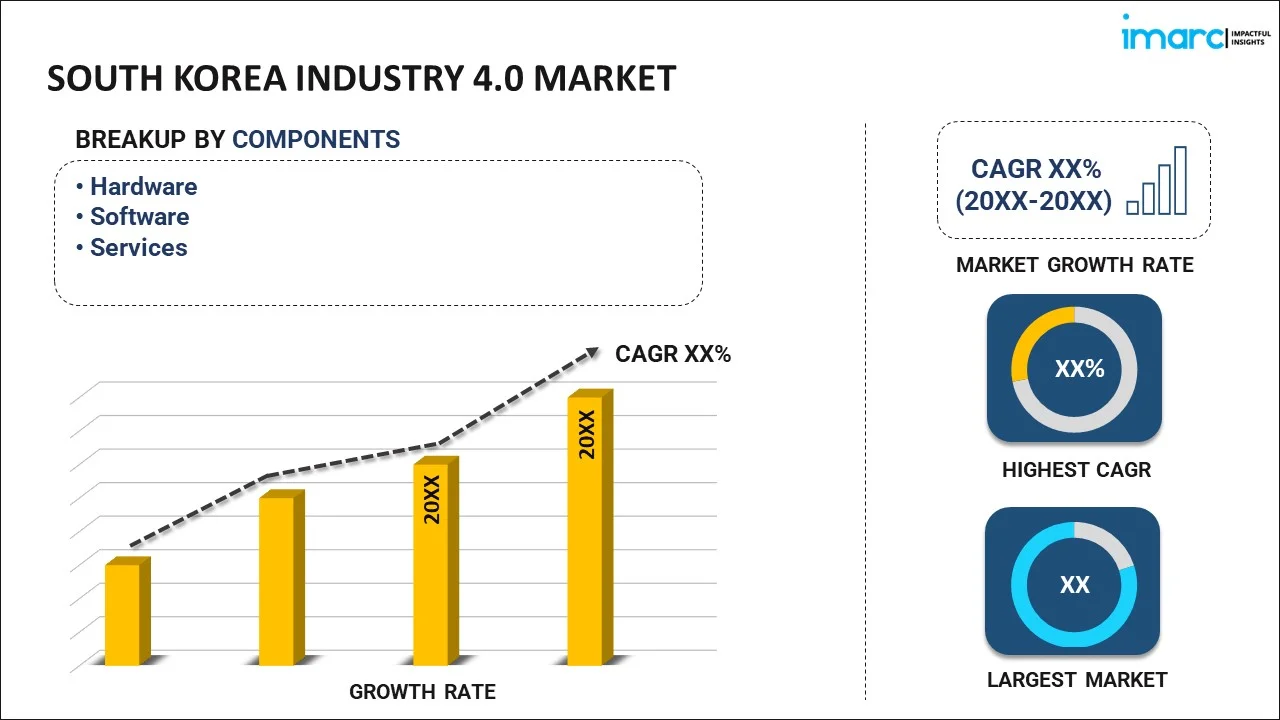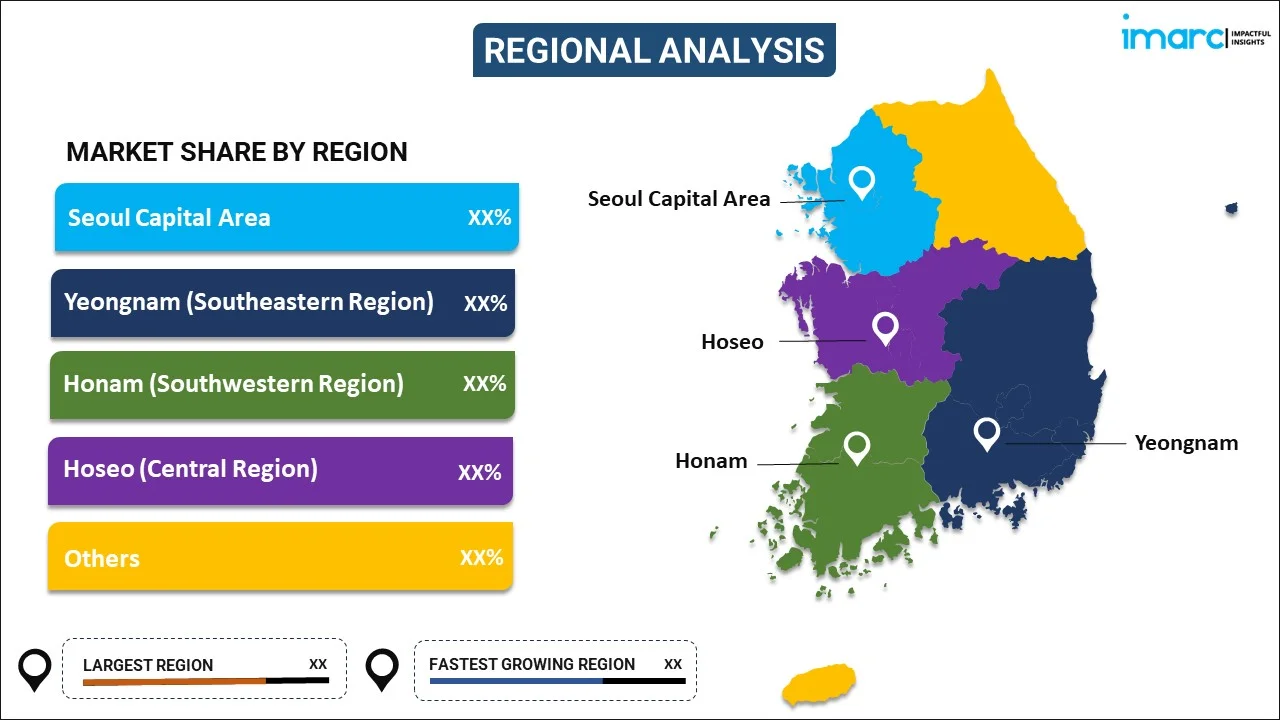
South Korea Industry 4.0 Market Report by Component (Hardware, Software, Services), Technology Type (Industrial Robotics, Industrial IoT, AI and ML, Blockchain, Extended Reality, Digital Twin, 3D Printing, and Others), End Use Industry (Manufacturing, Automotive, Oil and Gas, Energy and Utilities, Electronic and Foundry, Food and Beverages, Aerospace and Defense, and Others), and Region 2025-2033
Market Overview:
South Korea industry 4.0 market size reached USD 3,138.9 Million in 2024. Looking forward, IMARC Group expects the market to reach USD 10,534.4 Million by 2033, exhibiting a growth rate (CAGR) of 14.4% during 2025-2033. The growing automation of various industrial processes to reduce the occurrence of errors and improve operational efficiency, increasing integration of artificial intelligence (AI) and machine learning (ML), and rising need for robust security maintenance represent some of the key factors driving the market.
|
Report Attribute
|
Key Statistics
|
|---|---|
|
Base Year
|
2024 |
|
Forecast Years
|
2025-2033
|
|
Historical Years
|
2019-2024
|
| Market Size in 2024 | USD 3,138.9 Million |
| Market Forecast in 2033 | USD 10,534.4 Million |
| Market Growth Rate (2025-2033) | 14.4% |
Industry 4.0 refers to the addition of digital technologies, artificial intelligence (AI), the internet of things (IoT), big data analytics, and other emerging technologies into the manufacturing process. It comprises cyber-physical systems (CPS), which integrate computing elements and physical processes, creating a cohesive and intelligent network of machines. It aims to create a highly connected and intelligent industrial ecosystem where machines, processes, and humans communicate seamlessly. Industry 4.0 relies heavily on big data analytics to derive meaningful insights from the extensive amount of data generated during the manufacturing process. It enhances operational efficiency by automating routine tasks, optimizing processes, and reducing wastage. It enables manufacturing processes to become more flexible, allowing for quick adaptation to changing market demands. It is integrated with predictive maintenance and efficient resource utilization, which contributes to cost reduction by minimizing downtime and waste. It also ensures the production of high-quality products by reducing defects and errors. It allows real-time monitoring, control, and optimization of the entire production process. Industry 4.0 facilitates the production of customized and personalized products by providing the flexibility to adapt manufacturing processes quickly and efficiently.
South Korea Industry 4.0 Market Trends:
At present, the increasing automation of various industrial processes to reduce the occurrence of errors and improve operational efficiency represents one of the crucial factors impelling the market growth in South Korea. Besides this, the rising integration of AI and ML into Industry 4.0 solutions as they enable predictive maintenance, quality control, and demand forecasting is contributing to the market growth. The ability to examine vast amounts of data in real time enhances operational efficiency, minimizes downtime, and improves overall product quality, positioning companies at a competitive advantage. Blockchain technology is also emerging as a transformative trend within the Industry 4.0 landscape. It enhances trust among stakeholders, streamlines transactions, and contributes to the creation of more resilient and agile supply chains. In addition, businesses are increasingly recognizing the need to optimize their processes to remain competitive in the global market. Industry 4.0 technologies offer a holistic approach to process optimization, ranging from design and production to logistics and customer service, fostering a more agile and responsive enterprise. Apart from this, the rising demand for cost reduction and resource optimization among businesses is supporting the market growth in the country. Additionally, the increasing implementation of robust security maintenance to safeguard data and intellectual property is bolstering the market growth in South Korea.
South Korea Industry 4.0 Market Segmentation:
IMARC Group provides an analysis of the key trends in each segment of the market, along with forecasts at the country level for 2025-2033. Our report has categorized the market based on component, technology type, and end use industry.
Component Insights:

- Hardware
- Software
- Services
The report has provided a detailed breakup and analysis of the market based on the component. This includes hardware, software, and services.
Technology Type Insights:
- Industrial Robotics
- Industrial IoT
- AI and ML
- Blockchain
- Extended Reality
- Digital Twin
- 3D Printing
- Others
A detailed breakup and analysis of the market based on the technology type have also been provided in the report. This includes industrial robotics, industrial IoT, AI and ML, blockchain, extended reality, digital twin, 3D printing, and others.
End Use Industry Insights:
- Manufacturing
- Automotive
- Oil and Gas
- Energy and Utilities
- Electronic and Foundry
- Food and Beverages
- Aerospace and Defense
- Others
The report has provided a detailed breakup and analysis of the market based on the end use industry. This includes manufacturing, automotive, oil and gas, energy and utilities, electronic and foundry, food and beverages, aerospace and defense, and others.
Regional Insights:

- Seoul Capital Area
- Yeongnam (Southeastern Region)
- Honam (Southwestern Region)
- Hoseo (Central Region)
- Others
The report has also provided a comprehensive analysis of all the major regional markets, which include Seoul Capital Area, Yeongnam (Southeastern Region), Honam (Southwestern Region), Hoseo (Central Region) and Others.
Competitive Landscape:
The market research report has also provided a comprehensive analysis of the competitive landscape. Competitive analysis such as market structure, key player positioning, top winning strategies, competitive dashboard, and company evaluation quadrant has been covered in the report. Also, detailed profiles of all major companies have been provided.
South Korea Industry 4.0 Market Report Coverage:
| Report Features | Details |
|---|---|
| Base Year of the Analysis | 2024 |
| Historical Period | 2019-2024 |
| Forecast Period | 2025-2033 |
| Units | Million USD |
| Scope of the Report | Exploration of Historical and Forecast Trends, Industry Catalysts and Challenges, Segment-Wise Historical and Predictive Market Assessment:
|
| Components Covered | Hardware, Software, Services |
| Technology Types Covered | Industrial Robotics, Industrial IoT, AI and ML, Blockchain, Extended Reality, Digital Twin, 3D Printing, Others |
| End Use Industries Covered | Manufacturing, Automotive, Oil and Gas, Energy and Utilities, Electronic and Foundry, Food and Beverages, Aerospace and Defense, Others |
| Regions Covered | Seoul Capital Area, Yeongnam (Southeastern Region), Honam (Southwestern Region), Hoseo (Central Region), Others |
| Customization Scope | 10% Free Customization |
| Post-Sale Analyst Support | 10-12 Weeks |
| Delivery Format | PDF and Excel through Email (We can also provide the editable version of the report in PPT/Word format on special request) |
Key Questions Answered in This Report:
- How has the South Korea industry 4.0 market performed so far and how will it perform in the coming years?
- What has been the impact of COVID-19 on the South Korea industry 4.0 market?
- What is the breakup of the South Korea industry 4.0 market on the basis of component?
- What is the breakup of the South Korea industry 4.0 market on the basis of technology type?
- What is the breakup of the South Korea industry 4.0 market on the basis of end use industry?
- What are the various stages in the value chain of the South Korea industry 4.0 market?
- What are the key driving factors and challenges in the South Korea industry 4.0?
- What is the structure of the South Korea industry 4.0 market and who are the key players?
- What is the degree of competition in the South Korea industry 4.0 market?
Key Benefits for Stakeholders:
- IMARC’s industry report offers a comprehensive quantitative analysis of various market segments, historical and current market trends, market forecasts, and dynamics of the South Korea industry 4.0 market from 2019-2033.
- The research report provides the latest information on the market drivers, challenges, and opportunities in the South Korea industry 4.0 market.
- Porter's five forces analysis assist stakeholders in assessing the impact of new entrants, competitive rivalry, supplier power, buyer power, and the threat of substitution. It helps stakeholders to analyze the level of competition within the South Korea industry 4.0 industry and its attractiveness.
- Competitive landscape allows stakeholders to understand their competitive environment and provides an insight into the current positions of key players in the market.
Need more help?
- Speak to our experienced analysts for insights on the current market scenarios.
- Include additional segments and countries to customize the report as per your requirement.
- Gain an unparalleled competitive advantage in your domain by understanding how to utilize the report and positively impacting your operations and revenue.
- For further assistance, please connect with our analysts.
 Request Customization
Request Customization
 Speak to an Analyst
Speak to an Analyst
 Request Brochure
Request Brochure
 Inquire Before Buying
Inquire Before Buying




.webp)




.webp)












